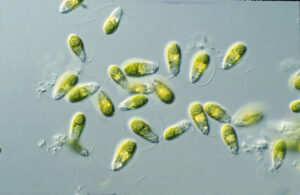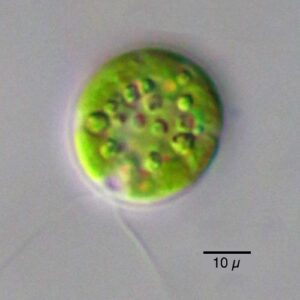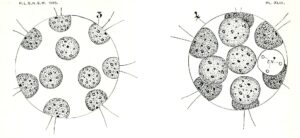This article will study several examples of colonial algae and provide comprehensive facts.
Colonial algae are algae made up of cells that seem like free-swimming unicells that form groups. There are two forms of colonial algae in the environment: motile colonial algae and non-motile colonial algae. They might be exceptionally huge or small and basic kinds of algae.
Sometimes, multicellular algae are confused with colonial algae. It is because of unicellular algae from a colony and not multicellular algae. Colonial algae can thrive on their own if parted, whereas multicellular algae cannot.
The following are some examples of colonial algae and some facts about them.
1. Volvox carteri
Volvox carteri is a member of the Volvocaceae family. It’s a colonial green algae species. It reproduces sexually and asexually in colonies. Male and female colonies of this kind of volvox algae are indistinguishable.
2. Volvox globator
Volvox globator belongs to the Volvocaceae family. It’s a type of green algae that grows in colonies. It is flagellated, which means it can move with its colonies. It lives in freshwater and is part of a colony of thousands of zooids.
3. Volvox aureus
Volvox aureus is a member of the Volvocaceae family. It’s a type of green algae that grows in spherical colonies. As a form of reproduction, asexual colonies are typically seen in freshwater.
4. Volvox africanus
Volvox africanus belongs to the Volvocaceae family. It was a chlorophyte species and lived in colonies, which have been extinct in large numbers and are no longer found on the planet.
5. Volvox tertius
Volvox tertius is a member of the Volvox Linnaeus genus and Volvocaceae family. It’s a green chlorophyte algae that grows in spherical colonies.

6. Volvox perglobator
Volvox perglobator is a member of the volvox genus. A hollow sphere of the cell forms a colony. It’s also a green chlorophyte alga.
7. Volvox spermatosphaera
Volvox spermatosphaera belongs to the Volvocaceae family of Chlorophyta volvox. It’s a colonial alga, with each alga living in its own colony.
8. Volvox reticuliferus
Volvox reticuliferus belongs to the Volvocaceae family of Chlorophyta volvox. They live in spherical colonies and are extremely beneficial to the ecosystem.
9. Volvox barberi
Volvox barberi belongs to the Chlorophyceae family. It’s a bi-flagellated green alga with bi-flagellated cells. To live, it develops spherical colonies.
10. Volvox rouseletti
Volvox rouseletti is a chlorophyte green algae and genus that is polyphyletic. It is a member of the Volvocaceae family. Aspherical colony form is seen in this type of algae.
11. Volvox dissipatrix
Volvox dissipatrix is a member of the Chlamydomonadales order. Majorly two different kinds of gametes are formed during sexual reproduction, which grow in colonies to survive.
12. Synura
Synura belongs to the Synurales family. It’s a small golden-brown algal group. This variety forms spherical colonies with cells aligned and flagella visible, which assists in their movement in the water.

13. Spirogyra
Mermaid’s tresses are the popular name for Spirogyra. It takes the form of filamentous colonies. We can define its life cycle as haplontic due to its colonial tendency.
14. Chlorella
Chlorella is a green alga with a single cell. It is a member of the Chlorellaceae family. It has a spherical shape and a high chlorophyll content. It is classified as a colonial alga since it is found in colonies.
15. Pandorina
Pandorina belongs to the Volvocaceae family. It’s a green algae genus bound together at the bottom to form a compact spherical colony encircled by mucilage.

16. Gonium
The Goniaceae family includes Gonium. It is identified to be a colonial algae genus. It has typical colonies, which consist of 4 to 16 cells.
17. Eudorina
The Volvocaceae family includes Eudorina. It is a species of green algae that live in colonies. Each Eudorina also has a flagellum, which allows it to migrate with its colonies.
18. Globe Algae
The Volvocaceae family includes Globe Algae. It is usually chlorophyte green algae. They can be found in a range of freshwater environments and form spherical colonies with up to 50k cells.
19. Dunaliella salina
Dunaliella salina is a form of unicellular microalgae that is typically green in color. It can be found in high salinity conditions and complete its life cycle in colonies.

20. Stephanosphaera
Stephanosphaera is a member of the Chlamydomonadales order. It’s a green alga that grows in spherical or ellipsoidal-shaped colonies.
21. Chlamydomonas
Chlamydomonas is an algae genus in the Chlamydomonadaceae family. Both unicellular and colonial algae have been identified. Chlamydomonas can be found in freshwater, seawater, and even snow.

22. Gloeomonas anomalipyrenoides
Gloeomonas anomalipyrenoides is a chlorophyte species belonging to the Volvocales family Chloromonadinia. It is classified as a colonial alga because it grows in colonies.
23. Cylindromonas fontinalis
Cylindromonas fontinalis is an algal species. It belongs to the Chlorophyceae family. It is discovered in colonies to live.
24. Protococcus
Protococcus is a single-celled green alga that belongs to the Protococcaceae family. It lives in freshwater habitats and forms dense colonies to ensure its survival.
25. Pleodorina
Pleodorina is a form of green algae that belongs to the Volvocaceae family. It mostly consists of spherical colonies generated from single spherical cells.
26. Conradimonas
Conradimonas is a member of the Volvocaceae family. It is found to be bi-flagellates that are unicellular or colonial in nature. It creates spherical colonies that have survived inversion two to three times during Chlamydomonadale progression.
27. Volvulina
Volvulina belongs to the Volvocaceae family. It is round or dome-shaped green algae that contain chloroplast. Volvulina can be found in colonies that are ellipsoidal or spherical.

28. Mastigosphaera
Mastigosphaera is a kind of algae belonging to the Volvocaceae family. It lives in colonies and has flagella, which makes it motile and allows it to travel with the colony.
29. Lundiella
Lundiella is a kind of algae in the Volvocaceae family. It’s a colonial member that lives in freshwater environments.
30. Scenedesmus
Scenedesmus belongs to the Scenedesmaceae family. It is a green alga that lacks flagellum and is non-motile in essence. It is a colonial alga that spends its entire life in colonies.

Also Read:
- Turbellaria characteristics
- Is fungi prokaryotic or eukaryotic
- Dna splicing types
- Is rubisco an enzyme
- Is adenine sugar
- Nucleotide examples
- Parenchyma cells in plants
- Monounsaturated fat vs polyunsaturated fat
- Zygote
- Do bacteria have flagella
Hey! I’m Roshny Batu. I got a Bachelor of Science degree in Botany. In the domain of academic writing, I consider myself fortunate to be a part of the Lambdageeks family as an SME in Bio-Technology. Apart from that, I love designing interiors, painting, and mastering makeup artist skills.